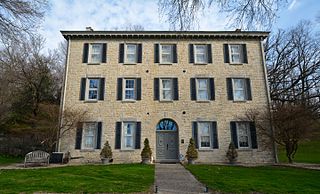
Dubuque is a city in and the county seat of Dubuque County, Iowa, United States, located along the Mississippi River. At the time of the 2020 census, the population of Dubuque was 59,667. The city lies at the junction of Iowa, Illinois, and Wisconsin, a region locally known as the Tri-State Area. It serves as the main commercial, industrial, educational, and cultural center for the area. Geographically, it is part of the Driftless Area, a portion of North America that escaped all three phases of the Wisconsin Glaciation.

Dubuque County is a county located in the U.S. state of Iowa. As of the 2020 census, the population was 99,266, making it the eighth-most populous county in Iowa. The county seat is Dubuque. The county is named for Julien Dubuque, the first European settler of Iowa.

Moline is a city located in Rock Island County, Illinois, United States. With a population of 42,985 in 2020, it is the largest city in Rock Island County. Moline is one of the Quad Cities, along with neighboring East Moline and Rock Island in Illinois and the cities of Davenport and Bettendorf in Iowa. The Quad Cities have an estimated population of 381,342. The city is the ninth-most populated city in Illinois outside the Chicago metropolitan area.

Peosta is a city in Dubuque County, Iowa, United States, and an exurb of the city of Dubuque. It is part of the Dubuque, Iowa Metropolitan Statistical Area. The population was 1,908 in the 2020 census, an increase of 193% from 651 in 2000. Peosta experienced a 70% increase in population (estimated) from 2000 to 2007, making it the state's 10th fastest-growing city during that period. Peosta is currently the sixth-largest city in Dubuque County, but it will likely soon pass Epworth (pop. 1,860) to become the fifth-largest. The community is home to the 2015 ASA D Northern Nationals Men's Slow Pitch Champions, Kass & Company, a large industrial park, the largest campus of Northeast Iowa Community College, and a handful of new commercial businesses. However, the city is increasingly becoming a bedroom community, much like nearby Asbury, made up of suburban subdivisions.

Loras College is a private Catholic college in Dubuque, Iowa. It has an enrollment of approximately 1,600 students and is the oldest post-secondary institution in the state of Iowa. The school offers both undergraduate and graduate degree programs. It is one of four four-year post-secondary institutions in the City of Dubuque, one of four Catholic colleges in the Archdiocese of Dubuque, and one of six Catholic colleges in the state of Iowa. The campus was listed on the National Register of Historic Places as the Loras College Historic District in 2020.

The Metropolitan Archdiocese of Dubuque is a Latin Church ecclesiastical territory or archdiocese of the Catholic Church in the northeastern quarter of the state of Iowa in the United States.

The University of Dubuque (UD) is a private Presbyterian university in Dubuque, Iowa. About 2,200 students attend the university.

St. Raphael's Cathedral is a Catholic cathedral and a parish church in the Archdiocese of Dubuque located in Dubuque, Iowa. The parish is the oldest congregation of any Christian denomination in the state of Iowa. The cathedral church, rectory, former convent, and former parochial school building are contributing properties in the Cathedral Historic District on the National Register of Historic Places.

Saint Mary's Catholic Church is a former parish of the Archdiocese of Dubuque. The church is located in Dubuque, Iowa, United States, at the corner of 15th and White Streets. The church is recognizable by its steeple– one of the tallest in the area. The church property was added to the National Register of Historic Places as an historic district in 2015, and the various buildings were included as contributing properties in the Washington Residential Historic District later in the same year.

Mathias Loras was French Catholic priest in the United States who served as the first Bishop of Dubuque, in what would become the state of Iowa.

Wahlert Catholic High School is a private Roman Catholic high school in Dubuque, Iowa, United States, in the Roman Catholic Archdiocese of Dubuque.

Mary Frances Clarke, B.V.M. was an Irish nun who founded the Catholic order of the Sisters of Charity of the Blessed Virgin Mary.

U.S. Highway 20 (US 20) in Iowa is a major east–west artery which runs across the state, separating the northern third of Iowa from the southern two-thirds. It enters Iowa from Nebraska, concurrent with Interstate 129 (I-129) and US 75, crossing the Missouri River at Sioux City. US 20 runs in a more-or-less straight line across Iowa, paralleling 42° 27' N. It leaves Iowa in Dubuque by crossing the Mississippi River into Illinois. Since October 2018, US 20 is a four-lane divided highway for its entire length in Iowa.

The Port of Dubuque is the section of downtown Dubuque, Iowa, USA, that is immediately adjacent to 579.4 mile to the Mississippi River. The area was among the first areas settled in what became the City of Dubuque, and the State of Iowa. Historically, the area has been a center of heavy industry, but has recently seen extensive reinvestment and new construction. The area is now one of the main tourist destinations in Dubuque, as well as Iowa.

The Iowa flood of 2008 was a hydrological event involving most of the rivers in eastern Iowa which began June 8 and continued until July 1. Flooding continued on the Upper Mississippi River in the southeastern area of the state for many more days. The phrase "Iowa's Katrina" was often heard.

St. Mary of the Visitation Catholic Church is a parish of the Diocese of Davenport. The church building is located on the corner of 4th and Court Streets in downtown Ottumwa, Iowa, United States. It is part of the Central Park area, which is the civic center of the community. It includes: the Wapello County Courthouse, the Ottumwa Public Library, and the Ottumwa City Hall. The church is eligible for the National Register of Historic Places, but it has not been listed.

Jean-Antoine-Marie Pelamourgues (1811–1875) was a French missionary who was one of the first Roman Catholic priests to serve in the Diocese of Dubuque in the state of Iowa. He served as the first pastor of St. Anthony's Church in Davenport, Iowa from 1839 to 1868.
John George Alleman was a missionary Catholic priest who served in the states of Ohio, Iowa and Illinois. He served as a priest in the Dominican Order from 1834 to 1840, after which time he was expelled from the order. He then served as a secular priest in the Diocese of Dubuque from 1840 to 1851, and in the Diocese of Chicago from 1851 to 1863. During his hospitalization in St. Louis, Missouri, (1863–1865) he was accepted back into the Dominican Order.

U.S. Highway 67 (US 67) is a U.S. Highway in extreme eastern Iowa. The route begins in Davenport at the Rock Island Centennial Bridge where it crosses the Mississippi River and ends at an intersection with US 52 and Iowa Highway 64 (Iowa 64) west of Sabula. It passes through Bettendorf, Le Claire, and Clinton. Except for Folletts, every community which US 67 enters sits along the Mississippi River. As such, most of the route is part of the Great River Road, an All-American Road.

Mount Saint Bernard Seminary and Barn are historic buildings located south of Dubuque, Iowa, United States. Bishop Mathias Loras, the first Bishop of Dubuque, founded the a Catholic institution of higher education in his residence in 1839. St. Raphael's Seminary, primarily for the education of priests, was probably the first college established in what would become the State of Iowa. The Brothers of Christian Instruction, a French teaching order recruited to the diocese of Loras, contributed their services to the seminary. The school was expanded in 1850 when he began the construction of three new buildings on Table Mound that he named Mount St. Bernard College and Seminary. The Rev. Andrew Trevis, who was later influential in the development of Sacred Heart Cathedral in Davenport, was the rector at the time the building was constructed. The three-story limestone combination Federal and Greek Revival structure was designed by local architect Hugh V. Gildea. It was built for $10,000, which was a lot of money for the diocese at that time. It is unknown when the frame, gable-roofed barn with a stone foundation was built.

























